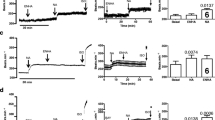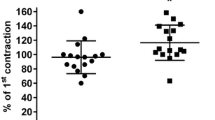Summary
An increase in cyclic nucleotide monophosphate levels is suggested to play a prominent role in mediating smooth-muscle relaxation. Cyclic nucleotide phosphodiesterase (PDE) influences smooth-muscle tone by decreasing the level of cyclic nucleotides. At present, five different families of isoenzymes of PDE exist that show a distinct species- and organ-specific distribution. Our study was done to evaluate the existence of specific PDE isoenzymes and its functional role in human ureteral tissue. Normal ureteral tissue was homogenized and centrifuged and the supernatant fraction was separated using anioin-exchange diethylaminoethyl (DEAE)-Sephacel chromatography. A PDE assay was then performed and the peak fractions were added to different specific PDE activators and inhibitors. In vitro, longitudinal ureteral strips were precontracted and different selective and nonselective PDE inhibitors were added incremently. Three different PDE isoenzymes were characterized: PDE I (calmodulin-sensitive), PDE II (cGMP-stimulated), and PDE IV (cAMP-specific). All PDE inhibitors relaxed the strips dose-dependently, with the 50% effective concentrations (EC50) being 30 μM for papaverine, 40 μM for zaprinast, 25 μM for quazinone, and 0.1 μM for rolipram. The ureter-relaxing effect of the PDE IV inhibitor at low concentrations, combined with its low-level effect on the systemic circulatory parameters, may open the possibility of using selective PDE IV- inhibitors in the treatment of ureteral colics or for ureteral stone passage.
Similar content being viewed by others
References
Drach GW (1986) Urinary lithiasis. In: Walsh PC, Gittes RF, Perlmutter AD, Stamey TA (eds) Campbell's urology. WB Saunders, Philadelphia, pp 1094–1122
Hartmann M (1991) Urologische Notfall-Situationen (ohne Verletzungen). In: Altwein JE, Rübben H (eds) Urologie. Ferdinand Enke, Stuttgart, 395–424
Gruber CM (1928) The effect of morphine and papaverine upon the peristaltic and antiperistaltic contractions of the ureter. J Pharmacol Exp Ther 33:191–199
El-Sherif AE, Foda R, Norlen LJ, Yahia H (1990) Treatment of renal colic by prostaglandin synthetase inhibitors and avafortan (analgesic antispasmodic). Br J Urol 66:602–605
Friedman MR (1990) Nonsteroidal anti-inflammatory drugs facilitate stone passage. Urology 35:374
Caine M (1984) The autonomic pharmacology of the urinary tract. In: Caine M (ed) The pharmacology of the urinary tract. Springer, Berlin Heidelberg New York, pp 5–27
Itoh T (1991) Pharmacomechanical coupling in vascular smooth muscle cells, an overview. Jpn J Pharmacol 55:1–9
Beavo JA (1990) Multiple phosphodiesterase isoenzymes. Background, nomenclature and implications. In: Beavo JA, Houslay MD (eds) Cyclic nucleotide phosphodiesterases: structure, regulation and drug action. John Wiley & Sons, West Sussex, pp 3–15
Thompson WJ, Brooker G, Appleman MM (1971) Assay of cyclic nucleotide phosphodiesterases with radioactive substrates. Biochemistry 10:311
Lakey T, Pyne N, Murphy G (1990) Cyclic nucleotide. In: Siddle K, Hutton JC (eds) Peptide hormone action. A practical approach. IRL/Oxford University Press, New York, pp 101–108
Dixon M, Webb EC (1979) Enzyme kinetics. In: Dixon M, Webb EC (eds) Longmans, London, pp 47–206
Weiss RM, Wheeler MA (1988) Insulin activation of cyclic AMP phosphdiesterase in intact Ureteral segments. J Pharmacol Exp Ther 247:630–634
Weiss RM (1981) Resistance of a separate from of canine ureteral phosphodiesterase activity to inhibition by xanthines and papaverine. Biochem Pharmacol 30:2371–2374
Wang JH, Sharma RK, Mooibroek MJ (1990) Calmodulin stimulated cyclic nucleotide phosphodiesterase. In: Beavo JA, Houslay MD (eds) Cyclic nucleotide phosphodiesterases: structure, regulation and drug action. John Wiley & Sons, West Sussex, pp 19–46
Reeves ML, England PJ (1990) Cardiac phosphodiesterases and the functional effects of selective inhibition. In: Beavo JA, Houslay MD (eds) Cyclic nucleotide phosphodiesterases: structure, regulation and drug action. John Wiley & Sons, West Sussex, pp 229–312
Conty M, Swinnen JV (1990) Structure and function of the rolipram sensitive, low Km cyclic cAMP phosphodiesterase: a family of highly related enzymes. In: Beavo JA, Houslay MD (eds) Cyclic nucleotide phosphodiesterases: structure, regulation and drug action. John Wiley & Sons, West Sussex, pp 68–91
Beavo JA, Raifsnyder DH (1990) Primary sequence of cyclic nucleotide phosphodiesterase isozymes and the design of selective inhibitors. TIPS 11:150–155
Author information
Authors and Affiliations
Rights and permissions
About this article
Cite this article
Taher, A., Schulz-Knappe, P., Meyer, M. et al. Characterization of cyclic nucleotide phosphodiesterase isoenzymes in the human ureter and their functional role in vitro. World J Urol 12, 286–291 (1994). https://doi.org/10.1007/BF00191209
Issue Date:
DOI: https://doi.org/10.1007/BF00191209




